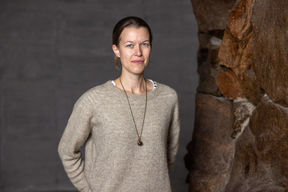Assistant professor Matilda Backholm of the Department of Applied Physics has been granted 496 000 euros by the Jane and Aatos Erkko Foundation and 150 000 euros from the Finnish Academy of Science and Letters for studying microscopic plant roots. In a time of climate upheaval, a better understanding of the microscale physics of tiny plant roots works toward growing resilient and high-yield crops, especially for use in plant-based food alternatives. The research centers around refining Backholm’s unique micropipette force probe, which enables measuring nanoscale physical forces extremely accurately.
Biomechanical forces from the cell up
The physics of tiny plant roots are complex and largely unknown. Microscopic plants roots, such as root hairs and young roots, help plants latch on to the soil. If the mechanical properties of the roots are too soft, they cannot penetrate dry compact soil; too stiff and they cannot deform to grow around hard objects while too weak roots cannot withstand being uprooted.
’Mechanical properties of roots are formed at the level of individual root cells and eventually determine much of the physics of this intriguing plant organ. Yet there is currently limited knowledge of how root cells contribute to the material properties of the root as a whole. We also don’t know how these multicellular living materials adapt to external physical stresses at the scale of cells,’ Backholm says.
Backholm works with the Jane and Aatos Erkko Foundation grant to answer these two questions.
With the Finnish Academy of Science and Letters Väisälä grant, Backholm’s Living Matter group starts studying many other knowledge gaps in plant root physics, for example, the dynamics of how microscopic plant roots sense gravity. This so-called gravitropic growth of roots helps them in growing downwards into the ground, finding water and becoming properly anchored to the ground, but its forces and mechanics are similarly shrouded in mystery for the most part.
Probing and modelling
In a work combining physics and biology, Prof. Backholm aims to further refine her existing unique micropipette force sensor to create a cutting-edge micromechanical tool for probing the mechanical qualities of roots. Working at the force scale of nano-Newtons, Backholm mainly studies the roots of the Thale Cress—a staple of plant sciences. The work also involves state-of-the-art analytical modelling to determine mechanical properties and growth dynamics of microscopic roots.
‘The result, a better understanding of microscale plant root physics, will help producers tailor plants to different soils and climates. It also helps in combating erosion and increasing food productivity—crucial developments at a time when plant-based food alternatives are urgently needed to fight climate change,’ Backholm says.
The research also includes industry collaboration with the Finnish company Boreal Plant Breeding Ltd. to probe the mechanical properties of important crops like oat and wheat—all with the aim of gathering data to improve future crops.
The research is done as part of the Living Matter research group headed by Backholm at the Department of Applied Physics. The four-year project starts this year.












